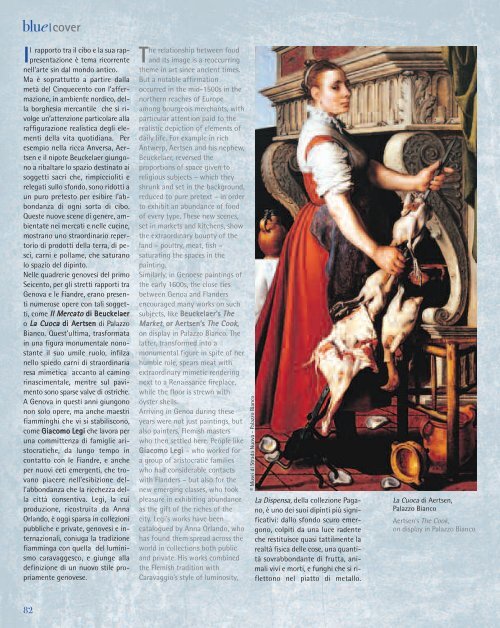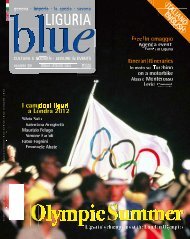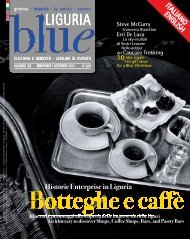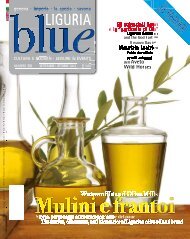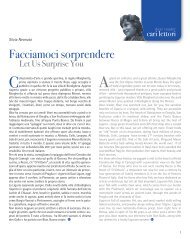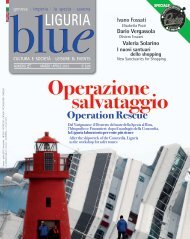cover - Blue Liguria - Sagep
cover - Blue Liguria - Sagep
cover - Blue Liguria - Sagep
You also want an ePaper? Increase the reach of your titles
YUMPU automatically turns print PDFs into web optimized ePapers that Google loves.
lue<br />
Il rapporto tra il cibo e la sua rappresentazione<br />
è tema ricorrente<br />
nell’arte sin dal mondo antico.<br />
Ma è soprattutto a partire dalla<br />
metà del Cinquecento con l’affermazione,<br />
in ambiente nordico, della<br />
borghesia mercantile che si rivolge<br />
un’attenzione particolare alla<br />
raffigurazione realistica degli elementi<br />
della vita quotidiana. Per<br />
esempio nella ricca Anversa, Aertsen<br />
e il nipote Beuckelaer giungono<br />
a ribaltare lo spazio destinato ai<br />
soggetti sacri che, rimpiccioliti e<br />
relegati sullo sfondo, sono ridotti a<br />
un puro pretesto per esibire l’abbondanza<br />
di ogni sorta di cibo.<br />
Queste nuove scene di genere, ambientate<br />
nei mercati e nelle cucine,<br />
mostrano uno straordinario repertorio<br />
di prodotti della terra, di pesci,<br />
carni e pollame, che saturano<br />
lo spazio del dipinto.<br />
Nelle quadrerie genovesi del primo<br />
Seicento, per gli stretti rapporti tra<br />
Genova e le Fiandre, erano presenti<br />
numerose opere con tali soggetti,<br />
come IIll MMeerrccaattoo di Beuckelaer<br />
o LLaa CCuuooccaa di Aertsen di Palazzo<br />
Bianco. Quest’ultima, trasformata<br />
in una figura monumentale nonostante<br />
il suo umile ruolo, infilza<br />
nello spiedo carni di straordinaria<br />
resa mimetica accanto al camino<br />
rinascimentale, mentre sul pavimento<br />
sono sparse valve di ostriche.<br />
A Genova in questi anni giungono<br />
non solo opere, ma anche maestri<br />
fiamminghi che vi si stabiliscono,<br />
come Giacomo Legi che lavora per<br />
una committenza di famiglie aristocratiche,<br />
da lungo tempo in<br />
contatto con le Fiandre, e anche<br />
per nuovi ceti emergenti, che trovano<br />
piacere nell’esibizione dell’abbondanza<br />
che la ricchezza della<br />
città consentiva. Legi, la cui<br />
produzione, ricostruita da Anna<br />
Orlando, è oggi sparsa in collezioni<br />
pubbliche e private, genovesi e internazionali,<br />
coniuga la tradizione<br />
fiamminga con quella del luminismo<br />
caravaggesco, e giunge alla<br />
definizione di un nuovo stile propriamente<br />
genovese.<br />
82<br />
<strong>cover</strong><br />
The relationship between food<br />
and its image is a reoccurring<br />
theme in art since ancient times.<br />
But a notable affirmation<br />
occurred in the mid-1500s in the<br />
northern reaches of Europe<br />
among bourgeois merchants, with<br />
particular attention paid to the<br />
realistic depiction of elements of<br />
daily life. For example in rich<br />
Antwerp, Aertsen and his nephew,<br />
Beuckelaer, reversed the<br />
proportions of space given to<br />
religious subjects – which they<br />
shrunk and set in the background,<br />
reduced to pure pretext – in order<br />
to exhibit an abundance of food<br />
of every type. These new scenes,<br />
set in markets and kitchens, show<br />
the extraordinary bounty of the<br />
land – poultry, meat, fish –<br />
saturating the spaces in the<br />
painting.<br />
Similarly, in Genoese paintings of<br />
the early 1600s, the close ties<br />
between Genoa and Flanders<br />
encouraged many works on such<br />
subjects, like Beuckelaer’s TThhee<br />
MMaarrkkeett, or Aertsen’s TThhee CCooookk,<br />
on display in Palazzo Bianco. The<br />
latter, transformed into a<br />
monumental figure in spite of her<br />
humble role, spears meat with<br />
extraordinary mimetic rendering<br />
next to a Renaissance fireplace,<br />
while the floor is strewn with<br />
oyster shells.<br />
Arriving in Genoa during these<br />
years were not just paintings, but<br />
also painters, Flemish masters<br />
who then settled here. People like<br />
Giacomo Legi – who worked for<br />
a group of aristocratic families<br />
who had considerable contacts<br />
with Flanders – but also for the<br />
new emerging classes, who took<br />
pleasure in exhibiting abundance<br />
as the gift of the riches of the<br />
city. Legi’s works have been<br />
catalogued by Anna Orlando, who<br />
has found them spread across the<br />
world in collections both public<br />
and private. His works combined<br />
the Flemish tradition with<br />
Caravaggio’s style of luminosity,<br />
© Musei di Strada Nuova - Palazzo Bianco<br />
La Dispensa, della collezione Pagano,<br />
è uno dei suoi dipinti più significativi:<br />
dallo sfondo scuro emergono,<br />
colpiti da una luce radente<br />
che restituisce quasi tattilmente la<br />
realtà fisica delle cose, una quantità<br />
sovrabbondante di frutta, animali<br />
vivi e morti, e funghi che si riflettono<br />
nel piatto di metallo.<br />
La Cuoca di Aertsen,<br />
Palazzo Bianco<br />
Aertsen’s The Cook,<br />
on display in Palazzo Bianco


